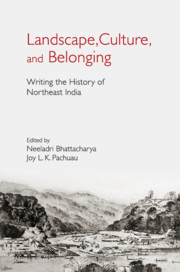Book contents
- Frontmatter
- Contents
- List of Figures
- Acknowledgements
- Introduction
- I Borders and Beyond
- II Surveys and Explorations
- III Ethnography, History, and the Politics of Representation
- 6 Naga: Lineages of a Term
- 7 Representing the Nagas: Negotiating National Culture and Consumption
- IV Law, State, and Practices of Governance
- V Cultural Dialogues
- Notes on Contributors
- Index
6 - Naga: Lineages of a Term
from III - Ethnography, History, and the Politics of Representation
Published online by Cambridge University Press: 26 April 2019
- Frontmatter
- Contents
- List of Figures
- Acknowledgements
- Introduction
- I Borders and Beyond
- II Surveys and Explorations
- III Ethnography, History, and the Politics of Representation
- 6 Naga: Lineages of a Term
- 7 Representing the Nagas: Negotiating National Culture and Consumption
- IV Law, State, and Practices of Governance
- V Cultural Dialogues
- Notes on Contributors
- Index
Summary
The German term ‘Hinterindien’ describes tellingly a conclusion that results from most research done on the northeastern region of today's India: ‘Hinterindien’ translates as ‘Further India’ or even as ‘beyond India’. The term can be found on early German maps showing the region which is the northeast India of today, as a region bordering the northwest of the area known in the nineteenth century as ‘Indochine’ in the French colonial context or ‘India Extra Gangem’ in even earlier Latin-language maps. The Northeast is shown in these early maps as an area that is geographically linked to Southeast Asia more than to the actual India of today – an association which could easily be transmitted to the cultural affiliations of the people inhabiting it. Through centuries, the plains and hills of Assam figured as meeting points of various cultures and religious traditions. In the plains mainly the large Buddhist, Hindu, and Islamic traditions left their traces, whereas in the hills it was animist beliefs and shamanistic practices that developed. Through these religious traditions, and their huge body of oral knowledge and mythology, many of the hill people of the Northeast are interlinked with various other groups not only in the entire Himalayan region, but also areas in southern China, Burma, and Thailand. This multitude of influences created a patchwork of varying, usually very local, ethnic identities in the region, sometimes limited only to a certain valley, a village, or even part of a village. Against this background it seems strange to find an ethnonym like ‘Naga’ that applies to people inhabiting a large geographical region. Where does it come from and on what historical base did it develop? Who, then, are the Nagas?
The historical roots of the ethnonym ‘Naga’, the term which today describes the various ethnic groups inhabiting parts of northeast India and northern Burma, lie in the colonial and recent history of this region. The term developed over the years to describe not only the togetherness of the various tribes but also grew to express the identity of the people being united underneath it. This essay focuses on the various origins and ‘lineages’ of the term ‘Naga’. Many of the traces we will follow are highly contestable and appear willingly constructed, as today's notion of being ‘Naga’ is a strongly political one.
- Type
- Chapter
- Information
- Landscape, Culture, and BelongingWriting the History of Northeast India, pp. 131 - 150Publisher: Cambridge University PressPrint publication year: 2019
- 2
- Cited by



